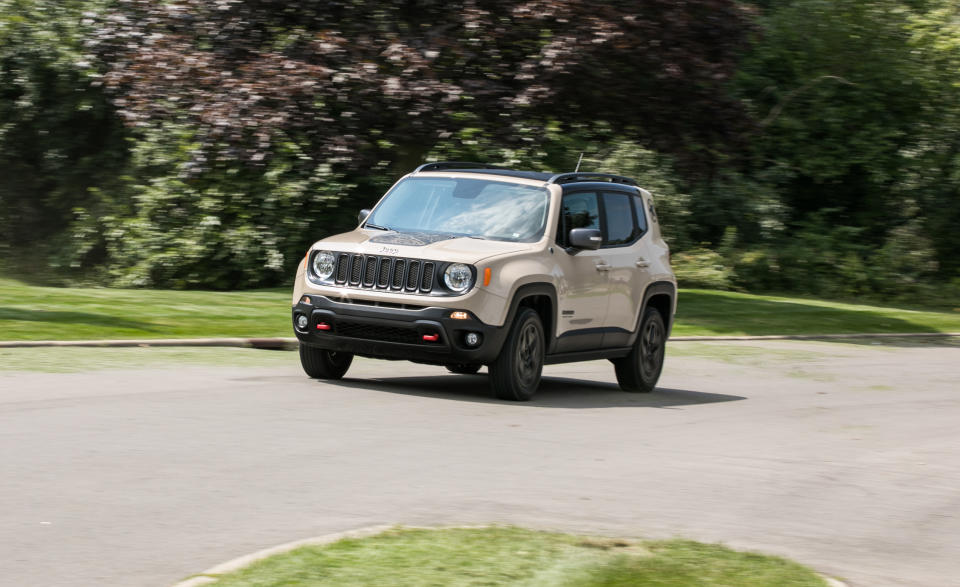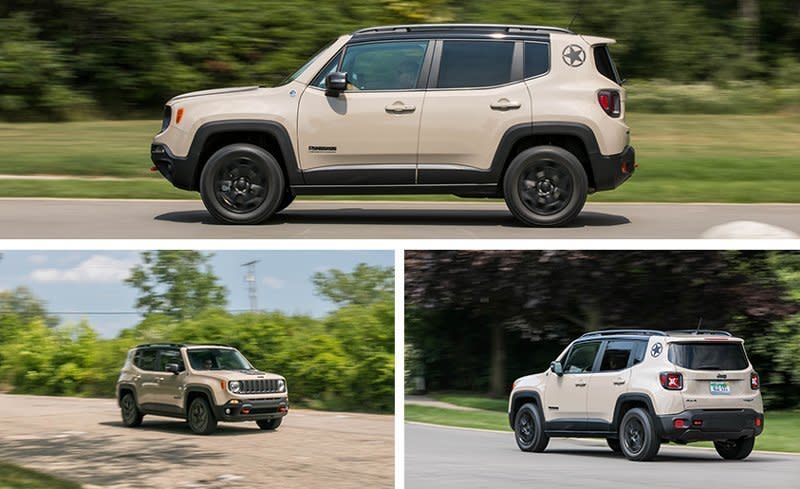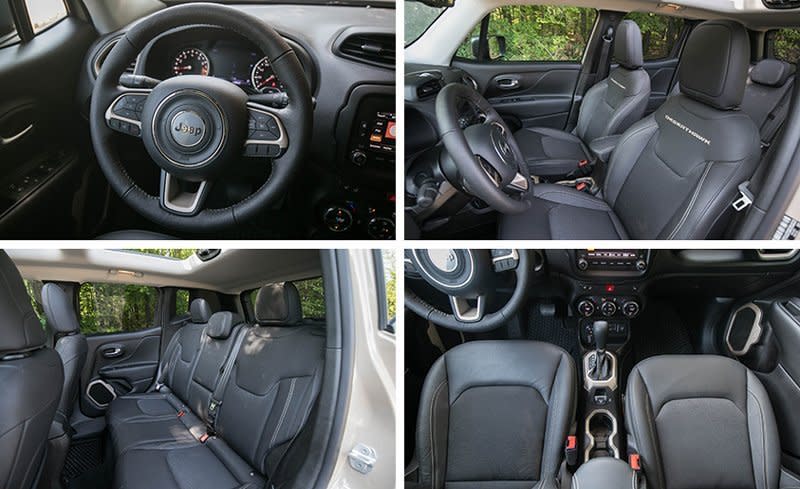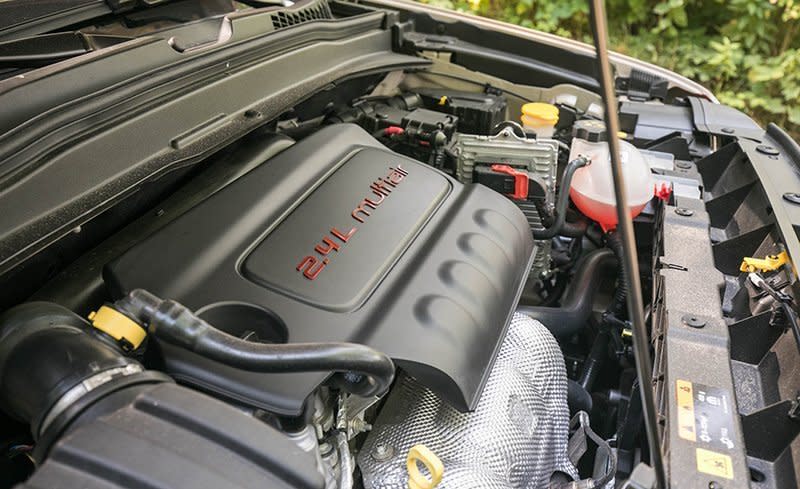2017 Jeep Renegade Deserthawk 2.4L 4x4

Deserthawk? What makes this version of the little crossover Jeep tested here a better bet for trekking in desert environments than the regular Renegade Trailhawk on which it’s based? Well, it includes rock rails as a standard feature, protecting the rocker panels over boulder-studded terrain. And it’s Trail Rated, which on the Renegade means it’s equipped with Jeep’s Active Drive Low four-wheel-drive system that includes a low range, as well as a new Rock mode for the Selec-Terrain system in addition to the standard Trailhawk’s Snow, Sand, Mud, and Auto selections. There’s a map graphic on the hood that is a stylized representation of Moab, Utah, and the surrounding area, along with other Deserthawk-specific styling details.
That region can’t really be called desert (too much annual rainfall), but it is definitely prime Jeep country. Every spring hundreds of Jeeps turn up for the Easter Jeep Safari, an annual rally organized by the Red Rock 4-Wheelers club that entails driving the myriad trails threading the spectacular terracotta sandstone landscapes that embrace Moab.

Jeeps infest the Moab area at other times, of course, and almost every one of those is a Wrangler, most of them with extensive suspension mods. So how many Renegade Deserthawks might we expect to see in Moab at the next Easter Jeep Safari? We predict it will be a round number such as zero. But if the Renegade is perceived as heretical by the hard-core Jeepers, it stacks up well against its competitive set.
Blitz Buggy Heritage
The Renegade was introduced as a 2015 model and established a new set of minimum dimensions for non-Wrangler Jeeps. It’s not all that far from the size of the Bantam Reconnaissance Car prototype that eventually morphed into the military Jeep, which as a prototype was called the Blitz Buggy by Bantam insiders.
The Renegade is a unibody, front-wheel-drive design with the option of a full-time four-wheel-drive system. It can tow up to 2000 pounds, which could be a pretty good-size piece of artillery. But despite the little World War II–style stars—and our test example’s Deserthawk-exclusive Mojave Sand paint job—the chances of seeing a Renegade in military service are nil.

In fact, this top-of-the-line model provides a fairly posh experience that’s totally absent in military vehicles, 1941 or now. The Deserthawk commands a $1495 premium over a normal Trailhawk, and its sporty all-black interior is nicely appointed with supportive power bucket front seats that feature leather bolsters and cloth inserts with contrasting stitching, a leather-wrapped steering wheel and shift knob, a 7.0-inch TFT info display, a 5.0-inch touchscreen with Bluetooth and satellite radio, and a six-speaker audio system.
Our test car was made even posher with the $1245 Navigation Group (6.5-inch touchscreen with Uconnect and navigation) and the $545 Cold Weather package (heated front seats, heated steering wheel, and a windshield wiper de-icer). The $645 Safety and Security Group brought blind-spot monitoring and rear cross-traffic alert, but the package price has been raised to $895 with the addition of HID headlights; our Renegade was built earlier before this packaging adjustment. The odd two-panel My Sky removable sunroof (which will be replaced for 2018 by a more conventional power sunroof) rounded out the options list at $1495. With a base MSRP of more than $28,000, a Deserthawk is already at the top of the charts for this class, and at more than $33K as tested it feels pretty pricey. The same money would put you in a much larger and well-equipped Jeep Compass.
What’s Your Hurry?
Sporty is not a term that comes to mind in connection with the Renegade’s straight-line performance. There are two engine options in the Renegade: a turbocharged 1.4-liter inline-four, which is available only with a six-speed manual transmission, or a naturally aspirated 2.4-liter four, the so-called Tigershark, paired with a nine-speed automatic. The 2.4-liter four and nine-speed combo is the only powertrain offered on the Trailhawk (and thus the Deserthawk).

The Tigershark has an edge in peak horsepower, but in this heftiest of little utes its thrust doesn’t bring to mind tigers, aquatic or terrestrial. Although the engine is one of the most powerful in the segment, trailing only the 201-hp Kia Soul Turbo, it’s propelling the pudgiest vehicle at more than 3600 pounds in Deserthawk trim, which adds up to languid acceleration: 10.3 seconds from zero to 60 mph.
With the exception of the Soul Turbo none in this class can be called quick, but the Renegade is the slowest of the bunch. And no one will call it thrifty, either. It gets 21 mpg city and 29 highway according to the EPA and returned just 18 mpg in our hands.
In the same vein, the combination of forward weight bias, high center of gravity, lofty ground clearance, and mild spring rates equals lots of body motion, reluctant turn-in responses, and determined understeer. The Renegade’s steering is relatively quick (2.8 turns lock-to-lock) and surprisingly tactile, but that’s not enough to make this mini-ute handy on pavement.

The Off-Road Advantage
But this Renegade comes into its own when the pavement ends. With 8.7 inches of ground clearance, skid plates (for the front suspension, transmission, transfer case, and fuel tank), four-wheel drive, and hill-descent control, the little Deserthawk can tackle some pretty tough terrain. You’ll probably never see one on the Rubicon Trail, but the Renegade can go places that would leave its competitors high-centered, gasping for breath, leaking oil, or worse.
There isn’t much desert in southeast Michigan, but there are plenty of gravel roads and forest tracks that challenged the Renegade’s suspension and ground clearance. The skid plates weren’t tested much, but we were impressed with the suspension’s ability to sop up washboard stretches and gaping potholes.
Bottom line: There are vehicles in this category that can outperform the Renegade on pavement—and for less money. But if actual off-road usefulness in a small package is important, the Renegade is the subcompact SUV to get.
Specifications >
VEHICLE TYPE: front-engine, 4-wheel-drive, 5-passenger, 4-door hatchback
PRICE AS TESTED: $33,665 (base price: $29,485)
ENGINE TYPE: SOHC 16-valve inline-4, aluminum block and head, port fuel injection
Displacement: 144 cu in, 2360 cc
Power: 180 hp @ 6400 rpm
Torque: 175 lb-ft @ 3900 rpm
TRANSMISSION: 9-speed automatic with manual shifting mode
DIMENSIONS:
Wheelbase: 101.2 in
Length: 166.6 in
Width: 74.2 in Height: 66.5 in
Passenger volume: 98 cu ft
Cargo volume: 19 cu ft
Curb weight: 3661 lb
C/D TEST RESULTS:
Zero to 60 mph: 10.3 sec
Zero to 100 mph: 36.2 sec
Rolling start, 5–60 mph: 11.0 sec
Top gear, 30–50 mph: 5.2 sec
Top gear, 50–70 mph: 7.6 sec
Standing ¼-mile: 17.9 sec @ 78 mph
Top speed (redline limited): 116 mph
Braking, 70–0 mph: 195 ft
Roadholding, 300-ft-dia skidpad: 0.72 g
C/D FUEL ECONOMY:
Observed: 18 mpg
75-mph highway driving: 26 mpg
Highway range: 330 miles
EPA FUEL ECONOMY:
Combined/city/highway driving: 24/21/29 mpg

 Yahoo Autos
Yahoo Autos 